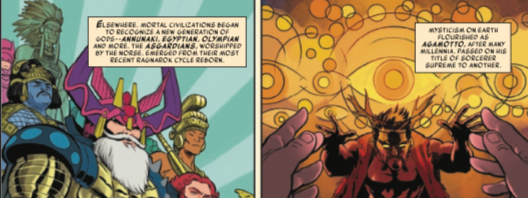History of the Marvel Universe #1 // Review
In 1986 DC Comics presented History of the DC Universe--a two-issue mini-series by writer Marv Wolfman and artist George Pérez which attempted to outline the comprehensive history of the world of DC Comics after the bewilderingly complicated events of Crisis on Infinite Earths. After Crisis, DC needed to clarify what was and was NOT a part of the new order. It was kind of a cool idea that Marvel has elected to visit over three decades later in its own History of the Marvel Universe. Written by Mark Waid with art by Javier Rodríguez, the first issue reveals a fluid outline of history that feels deeply inspired by Wolfman and Perez’s much more limited two-issue series.
At the beginning of the issue, it is the end of the Marvel Universe. There’s a little bit of time before the universe dies...so Galactus is asked by Franklin Richards to tell the story of the history of the Marvel Universe from its very beginning. Hovering cross-legged at the end of time, Galactus complies with the request and begins his brief history of the Marvel Universe. What follows is a lavishly-illustrated series of bullet points in which Galactus relates history. A story that starts with the dawn of time, and continues through the birth of the kid who would become Wolverine “near the end of the nineteenth century.” A tremendous amount of time is covered in 20 pages.
The opening of the six-issue mini-series reveals a very, very ambitious project. There have been nearly 60 years worth of comic book history since Fantastic Four #1. It’s worth pointing out that Waid isn’t alone in writing this thing. The credits list a research team of some nine people that aided Waid in putting together the story of the Marvel Universe told at the time of some imagined end. “It’s a series not just for hardcore Marvel fans,” says Waid in a promotional trailer for the series on YouTube, “although, they will love it.” I wish I could agree with him on that. Waid’s narrative style is somewhat comprehensive without being terribly engaging. Those not already familiar with the ancient history of the early Marvel universe aren’t likely to find much of interest here. For those who are... well, it’s interesting to note how comprehensive this history is, without providing much in the way of a universal timeline. It might be interesting to see the length of time that transpired between the birth of the universe and the emergence of the Phoenix Force. Or the rise of the Celestials and the beginning of the Kree-Skrull War and so on. Waid seems to have wanted to come up with something that’s more engaging than a simple “Wikipedia entry,” but a comprehensive picture of things laid-out in a more coherent way makes for something MUCH more engaging than what Waid’s delivering here. As it is, the history is excreted through a semi-poetic narrative that rushes around without a solid through-line. Galactus seems...maybe even a little disinterested in telling the story at the end of time. That being said, it’s kind of fun to hang out with Galactus at the end of time and listen to his almost stream-of-consciousness-seeming tale of time.
Rodríguez’s art is beautiful. The history of the Marvel Universe comes across in collages that mirror work Perez did for The History of the DC Universe thirty years ago. It’s nice to see an artist of similar caliber do something very similar for the Marvel Universe. Rodríguez is given the challenge of drawing characters created by numerous different artists from a variety of different eras in a breezy outline narrative breathed through the lips of a god. He does a pretty good job of it with vivid colors and a dynamic layout.
The issue ends with huge blocks of text appending Galactus’ story in a cramped, little cluster of pages. Giving specific citations of where many of the story elements had originated. While giving a greater sense of appreciation in the depth of what’s being delivered. Arguably, the last time Marvel tried anything this comprehensive, it was The Official Handbook of the Marvel Universe conceived by Jim Shooter and edited by Mark Gruenwald. That work gave more of a sweeping sense of the infinity of Marvel’s stories by grounding them in something that felt much more organized. The scope of this series is impressive, but it lacks the sense of the infinite that comes from a more rigidly-organized volume.










